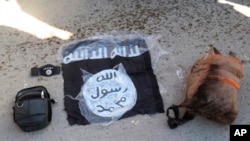U.S. officials tasked with tracking Islamic State are seeing worrisome signs that the terror group’s core leadership is strengthening control over its global network of affiliates despite a series of key losses.
Specifically, the United States is raising concerns about the group’s General Directorate of Provinces, a series of nine regional offices set up over the past several years to sustain the group’s reputation and global capabilities.
The U.S. State Department on Thursday highlighted the threat posed by these regional offices, designating the leaders of the offices in Iraq and in Africa’s Sahel region as Specially Designated Global Terrorists.
'Not yet done'
“We remain focused on cutting off ISIS’s ability to raise and move funds across multiple jurisdictions,” Secretary of State Antony Blinken said, speaking to a meeting in Riyadh of the global coalition that has been working to defeat Islamic State, also known as ISIS, IS or Daesh.
“For all our progress, the fight is not yet done,” Blinken added.
A separate State Department statement Thursday noted the terror group maintains connections to the global financial system and that IS’s core leadership has “relied on its regional General Directorate of Provinces offices to provide operational guidance and funding around the world.”
The new designations specifically name Abdallah Makki Muslih al-Rufay’I, the former emir of IS’s Iraq province, as the leader of the Iraq-based Bilad al-Rafidayn Office, and Abu Bakr ibn Muhammad ibn ‘Ali al-Mainuki as the leader of the al-Furqan office, which oversees operations in the Sahel.
Concern about the regional offices has been growing for more than a year, with a U.N. report warning in July 2022 that the offices were key to the terror group’s plans for “reviving its external operational capability."
The U.N. report cited the al-Furqan office, located in the Lake Chad Basin and charged with overseeing the terror group’s efforts in and around Nigeria and the western Sahel, as one of “the most vigorous and best-established [ISIS] regional networks.”
The report further warned that the Al-Siddiq office in Afghanistan and the Al-Karrar office in Somalia were likewise playing critical roles in Islamic State’s expansion.
Intelligence shared by U.N. member states at the time, however, suggested some of the other regional offices, including those in Turkey, Libya, Yemen and Egypt’s Sinai Peninsula, were struggling, and in some cases nonfunctional.
And despite a series of high-profile leadership losses, including the deaths or captures of at least 13 senior officials since early 2022, time seems to have worked in the terror group’s favor.
The regional office model, answering to the group’s core leadership, “has really enabled a lot of these groups to rapidly gain capability,” said Anand Arun, a U.S. Defense Intelligence Agency senior officer and analyst.
“They're pooling resources. They're sharing TTP [tactics, techniques and procedures]. They're sharing guidance,” Arun told a forum hosted by George Washington University’s Program on Extremism on Wednesday. “We're seeing ISIS’s local and regional attack capabilities in Africa increase.”
Enhanced internet ties
Others are also seeing IS affiliates, like IS West Africa Province, maximize these connections by using enhanced internet connections for what one expert described as “real-time communication.”
“We also saw conference calls, sometimes conference calls between ISIS central and African groups but also amongst African groups,” said Bulama Bukarti, a researcher and vice president at the Bridgeway Foundation, a charity that aims to prevent mass atrocities.
“They also share intelligence information, best practices,” he said, speaking at the same forum as Arun. “So, for example, if one affiliate looted a particular weapon they don't know how to operate, they just would take a photo of it, put it in the group [chat], and then someone would send them instructions, would send them a YouTube link with instructions on how to operate it.”
Bukarti also warned that IS’s adoption of advanced technologies has extended to other areas, with IS West Africa Province conducting trials on how to arm commercial drones to be used in attacks.
U.S. officials share the concern.
“I'm very much concerned about that and kind of the trajectory,” said the DIA’s Arun, calling the possibilities “exponential.”
“I think there's a lot of ways that they can harness what's coming with AI [artificial intelligence] and drones and other things,” he said.
Already, the United States has been leading efforts to crack down on these networks.
Last November, the Treasury Department sanctioned a smuggling network in Somalia that may have been linked to IS’s Al-Karrar regional office.
And in January, U.S. special operations forces killed Bilal al-Sudani, a key IS financial facilitator, during a raid on a mountainous cave complex in a remote part of northern Somalia.
But some of the information turned up during that operation has given U.S. officials cause to worry about IS’s growing technological prowess.
“If Bilal al-Sudani can access the internet from a cave in the Puntland of Somalia, I think they can figure it out,” Arun said.









